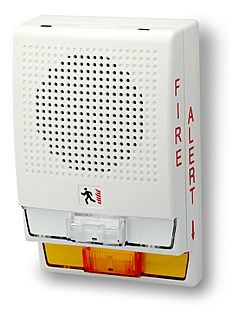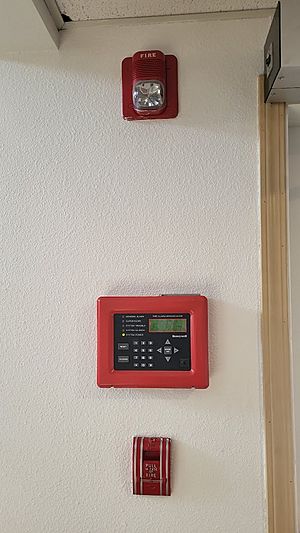Fire alarm system facts for kids
A fire alarm system is a special setup in buildings that helps find fires, smoke, carbon monoxide, or other dangers. It then tells everyone in the building and emergency helpers about the problem. Most big buildings need fire alarm systems. These systems often include smoke detectors, heat detectors, and special boxes you can pull to set off the alarm. All these parts connect to a main control panel, usually in a special electrical room. Fire alarms use loud sounds and bright flashing lights to warn people. Some systems can even stop elevators from working, because elevators are usually not safe to use during a fire.
Contents
How Fire Alarms Are Designed
Designing a fire alarm system means figuring out exactly what parts are needed and how they should work together. This is done to make sure the building is safe. Designers follow important rules and standards to make sure the system works well. These rules come from building codes, insurance companies, and other safety groups.
- One important international rule is ISO 7240-14. It helps guide how fire alarm systems are designed, installed, and maintained.
- In the United States, a common standard is NFPA 72, which is called The National Fire Alarm Code. Canada uses a similar standard from ULC.
- Europe also has its own rules, like TS 54 -14, which gives tips for planning and setting up fire alarm systems. Many European countries also have their own specific rules, like Germany with Vds 2095 and the United Kingdom with BS 5839 Part 1.
- In places like Australia, there are also standards that explain what fire alarm equipment needs to do to be safe.
Parts of a Fire Alarm System
A fire alarm system has several key parts that work together to keep a building safe:
- Fire Alarm Control Panel (FACP): This is like the brain of the system. It watches all the other parts, controls the alarms, and sends out information.
- Remote Annunciator: This device connects to the main control panel. It lets firefighters or other emergency workers see what's happening with the system and control it from a different spot, often near the building's front door.
- Main Power Supply: This is usually the regular electricity from the building. In big buildings, the fire alarm system has its own special power line.
- Backup Power Supplies: These are usually batteries or generators. They make sure the fire alarm system keeps working even if the main power goes out. The batteries might be inside the control panel or in a separate box nearby.
- Starting Devices: These are the parts that first notice a fire or are used to start the alarm. They can be turned on manually or automatically. Examples include:
* Pull stations (where you pull a lever). * Heat detectors (which sense high temperatures). * Smoke detectors (which sense smoke). * Duct detectors (which check for smoke in air vents). Smoke and heat detectors come in different types, like beam, photoelectric, or ionization.
- Alarm Devices: These parts make noise or flash lights to tell people to leave. They get their power from the fire alarm system. They can be:
* Flashing strobe lights (often made with xenon or LED lights). * Loud horns or sirens. * Chimes or bells. * Speakers that give voice instructions. Sometimes, these devices combine sounds and lights.
- Building Safety Connections: These connections allow the fire alarm system to control other parts of the building. This helps prepare the building for a fire. For example, they can control air movement, lights, and even how people move around. This helps stop smoke and fire from spreading.
How Alarms Are Started
Fire alarms can be started in two main ways:
- Manual Devices: These are often called pull stations or call points. They are placed where people can easily find and use them, usually near exits. To set them off, you usually pull a lever or break a small piece of glass.
- Automatic Devices: These devices sense changes that happen during a fire.
* Heat detectors sense high temperatures. * Smoke detectors sense smoke. * Flame detectors sense the light from flames. * Fire gas detectors sense gases from a fire. * Water-flow detectors sense when sprinklers turn on. Newer systems can even use cameras and computers to spot fires in places where other detectors might not work well.
What the Alarms Sound Like

Fire alarms can be loud bells or wall-mounted sounders and horns. Some systems use speaker strobes that play an alarm sound, then give clear voice messages about what to do. The sounds can be set to different tones and volumes.
- In the United States, fire alarms usually make a special three-pulse sound called Temporal Code 3. It sounds like: 0.5 seconds on, 0.5 seconds off, 0.5 seconds on, 0.5 seconds off, 0.5 seconds on, then 1.5 seconds off. Many modern systems also use voice messages. Older systems might just have a continuous sound.
- In the United Kingdom, fire alarms often make a two-tone siren sound. They also have flashing lights in public areas. Some alarms in schools have a different sound for things like class changes or break times.
- Some fire alarm systems have speakers that can give live or pre-recorded instructions. These are used in large buildings where it's hard for everyone to leave at once, like hospitals. The speakers can tell people exactly what to do and where to go to stay safe. Trained staff can also use a microphone to give real-time instructions.
Voice Alarm Systems
Some fire alarm systems use emergency voice alarm communication systems (EVAC). These systems play pre-recorded and live voice messages. EVAC systems are often found in tall buildings, sports arenas, and other large places like hospitals. In these places, it might be hard to get everyone out quickly.
- Voice systems help emergency workers guide people safely and tell them if the situation changes.
- In tall buildings, different messages might play on different floors. For example, floors near the fire might be told to leave, while floors much lower might be asked to wait for instructions.
Mass Notification Systems
Newer rules have led fire alarm makers to improve their systems. Now, many systems can send out different types of emergency messages. This includes warnings for bad weather, security alerts, or even missing person alerts. These are called mass notification systems.
- The main goal of a mass notification system is to send messages in the right order, based on the building's emergency plan.
- These systems also need to have flashing lights along with sounds to help people with disabilities.
- Mass notification systems can send messages to computers, digital signs, emails, text messages, or even through phone calls that read out the message.
Fire Systems in Homes
Fire alarm systems are also common in homes. The rules for home systems are not as strict as for commercial buildings. Home fire alarms are often part of a security system. In the United States, a home fire alarm system is needed if more than 12 smoke detectors are used. Home systems are simpler and have fewer parts than systems in big buildings.
Building Safety Connections
Fire alarm systems can connect to and control other parts of a building to improve safety:
- Magnetic Smoke Door Holders: These are magnets on walls that hold open fire doors. When the fire alarm goes off, the magnets turn off. This allows the doors to close automatically. These doors help stop smoke from spreading, keeping air clear for people to breathe during an evacuation.
- Duct-Mounted Smoke Detection: These detectors are placed inside air ducts. If they find smoke, they can stop the air conditioning or heating system. They can also close special dampers. This prevents smoke and fumes from spreading through the building's air system.
- Emergency Elevator Service: When a fire alarm goes off, elevators can be called back to the ground floor. This helps firefighters use them and stops people from getting trapped in elevators or going to the floor where the fire is.
- Public Address Rack (PAR): This is a system that plays background music. When a fire alarm goes off, the fire alarm system can turn off the music. This makes sure that people can clearly hear the fire alarm or any emergency messages.
British Fire Alarm System Types
In the United Kingdom, fire alarm systems in non-home buildings follow guidelines from BS 5839 Part 1. There are different types of systems for different buildings. A system can be simple or very complex and expensive.
BS 5839 Part 1 groups fire alarm systems into categories:
- "M" manual system: These systems have no automatic detectors. People in the building must discover the fire and pull a call point to set off the alarm. They are used in places of work where people are not sleeping.
- "L" automatic systems: These systems are designed to protect people's lives.
- "P" automatic systems: These systems are designed to protect property.
The automatic systems ("L" and "P") are further divided into more specific types:
- P1: This system is installed throughout almost the entire building. Its goal is to call the fire department as fast as possible to reduce damage from the fire.
- P2: Detectors are placed in parts of the building where a fire is more likely to start or where valuable items are kept. This helps reduce business problems if a fire happens.
- L1: This system has automatic detectors everywhere in the building, even in roof spaces and hidden areas. The goal is to give the earliest possible warning to everyone. This is often used in places like care homes.
- L2: This system has automatic detectors in escape routes, rooms next to escape routes, and rooms with high fire risk (like kitchens). It gives more protection than an L3 system.
- L3: This system aims to give early warnings to everyone. Detectors are placed in all escape routes and all rooms that open onto escape routes. This helps people leave before escape routes become blocked.
- L4: This system only covers escape routes and hallways. Detectors are placed in these areas to protect the path people use to get out.
- L5: This is for special situations, like computer rooms that might have a special fire extinguishing system. It covers unique needs not met by other categories.
Fire Alarm Zones
When designing fire alarms, buildings are often divided into different areas called zones. This helps firefighters quickly find where a fire is. Here are some general ideas for zoning:
- A single zone should not be bigger than about 2,000 square meters (about 21,500 square feet).
- In larger systems, if two parts of the system fail, they should not affect an area larger than about 10,000 square meters (about 107,600 square feet).
- A building smaller than about 300 square meters (about 3,200 square feet) can be considered one single zone.
- If a building is larger than 300 square meters, each zone should usually be on a single floor.
- Stairwells and elevator shafts should be their own separate zones.
- The farthest you should have to travel within a zone to find the fire should not be more than about 60 meters (about 200 feet).
It's also a good idea to have a list near the main control panel that shows which devices are in each zone.
Images for kids
See also
 In Spanish: Sistemas de detección y alarma de incendios para niños
In Spanish: Sistemas de detección y alarma de incendios para niños
- Fire Safety Equivalency System
- Multiple-alarm fire
- National Fire Protection Association
- Smoke detector
- Fire drill
- False alarm
- EN 54 – European Standard for Fire detection
- Emergency population warning - a way to warn people through audible and visual devices when peoples lives are in danger.








